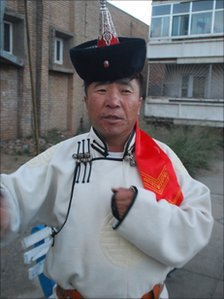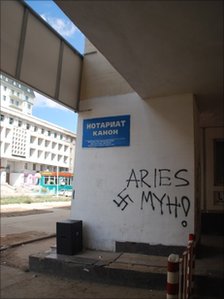|
BBC
News |
|
September 5, 2010 |
|
Ulaanbaatar |
|
|
|
 |
|
|
Erdenebileg Zenemyadar heads far-right group
Dayar Mongol
|
|
 |
|
|
Soronzon Jamsran says the Mongolian nation
should remain "pure"
|
|
 |
|
|
Activists say economic discontent is fuelling
violence from far-right groups |
|
 |
|
|
Signs of the far-right movement can be seen in
the capital, Ulan Bator
|
|
On a
hillside high above the Mongolian capital Ulan Bator, the
Zaisan Memorial commemorates the soldiers who lost their
lives in World War II.
Mongolians helped the Soviets defeat the Nazis and, for
decades after, Moscow's influence was strongest here.
But
these days China pours more money into this country than any
other does. Some of it is aid. Some of it is investment.
China's People's Liberation Army has handed over nearly $3m
(£1.95m) this year in aid to the Mongolian military.
At a
signing ceremony at the defence ministry, senior officers
from both countries toasted each other after two generals
signed their latest agreement. Everyone smiled.
But
some Mongolians are suspicious of these close ties. They
want to know what China really wants.
They
suspect their powerful neighbour is a bully, not a
benefactor, and that such co-operation could, in time, start
to undermine the Mongolian way of life.
'Just nationalism'
The
signs of their resentment are not hard to find. Swastikas
and slogans are daubed on walls across the city.
On the
internet the groups show how they are fighting back against
what they see as attempts to dilute the Mongolian race.
A
YouTube video shows a man shaving the head of a Mongolian
woman. Next to her a Chinese man sits with his hands over
his face.
It is
a very public warning to Mongolian women. This is what
happens if you sleep with Chinese men.
It was
posted by a member of a far-right group called Dayar Mongol.
Erdenebileg Zenemyadar is its founder. His group's website
shows members carrying Nazi flags. The swastika is part of
the group's logo.
However, he insists he is a nationalist, not a Nazi. He
comes to meet us in traditional dress - the kind of outfit
nomadic herders wear out on the steppes.
His
organisation is blamed by human rights groups for dozens of
attacks on women, foreigners and others they see as
threatening the purity of their race.
Violence he condemns, but he defends the shaving of the
woman's head.
"I
think this is right," he says. "If you ask the Mongolian
people what they think about it, the majority of people
would support that act."
While
he says his organisation does not order or sanction attacks,
he offers this explanation for them.
"Young
people see foreigners breaking the law and they're not
happy," he says. "So they're threatening them, sometimes
robbing them. It's wrong but it's happening a lot.
"Sometimes they are our members but the majority are not.
Maybe they're our supporters but we don't know them."
One of
his members joins our conversation. Soronzon Jamsran is 28
years old. He is an electrician and a new recruit to Dayar
Mongol.
He is
wearing combat trousers, a black t-shirt and, round his
neck, a swastika on a chain.
"In
Mongolian we call this the khas symbol," he says.
"Germany's nationalists tried to cleanse their nation, so
for me [the swastika] stands for keeping our nation pure.
It's not like I support Germany or I'm a Nazi. It's just
nationalism."
'Scapegoats'
Robyn
Garner, a gay activist in Ulan Bator, is sympathetic to the
concerns many Mongolians have about the activities of
foreign corporations here.
"You
have a large section of the population watching resources,
assets being sold off to foreigners," she says.
"I can
understand that people are looking for scapegoats, for
ideologies to channel their concerns."
But
she is worried that the discontent is fuelling the violent
agenda of the far-right groups who are targeting her
community.
Two
transgender women had to flee the country after they were
assaulted.
A
19-year-old gay man was stripped and beaten in the suburbs
after leaving a monthly gay party.
Otgonbaatar Tsedendemberel, another activist, says he has to
be constantly on guard against the threat of attack when
walking down the street.
"I'm
in constant fear," he says, "and unless we do something it's
just going to get worse and worse."
Luvsandendev Sumati, a Mongolian opinion pollster, points
out that in the 2008 parliamentary elections, the party
associated with these far-right groups won less than 1% of
the vote.
They
are still operating on the margins, he argues, although he
does feel they reflect concerns that many share here.
"Small
cultures are dissipating and disappearing," he said.
"It's
a real threat. In some ways Mongolian society should react
to that. The question is will it react in a civilised way or
will it try to go to extremes?"
Some
here argue these groups are adopting the symbols of the
Nazis because they are not yet a strong enough political
force to create their own ideology.
But
those targeted by them feel they are a real threat and their
influence is growing.
Perhaps that is no surprise. We found one city centre bar
filled with Nazi memorabilia.
There
were swastikas painted on the floor, reproductions of
propaganda posters on the wall, even mannequins dressed in
Nazi uniforms.
Inside
there were not extremists, just girls on a night out, a
couple drinking quietly in one corner - no-one, it appeared,
giving a second thought to the idea that these symbols would
provoke offence elsewhere.
The
threats, the violence, the use of Nazi symbols all help to
garner attention for the extremist groups here - Nazis or
nationalists, the label does not really matter.
They
seem to enjoy the notoriety it brings.
The
challenge for Mongolia's authorities will be to address the
concerns that fuel their anger and resentment and win them
support, while limiting their opportunity to do real harm.
|





